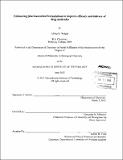| dc.contributor.advisor | Alexander M. Klibanov. | en_US |
| dc.contributor.author | Weight, Alisha K. (Alisha Kessel) | en_US |
| dc.contributor.other | Massachusetts Institute of Technology. Department of Chemistry. | en_US |
| dc.date.accessioned | 2013-11-18T19:08:48Z | |
| dc.date.available | 2013-11-18T19:08:48Z | |
| dc.date.copyright | 2013 | en_US |
| dc.date.issued | 2013 | en_US |
| dc.identifier.uri | http://hdl.handle.net/1721.1/82323 | |
| dc.description | Thesis (Ph. D. in Biological Chemistry)--Massachusetts Institute of Technology, Dept. of Chemistry, 2013. | en_US |
| dc.description | Cataloged from PDF version of thesis. | en_US |
| dc.description | Includes bibliographical references. | en_US |
| dc.description.abstract | Major impediments to the full utility of current and potential drugs include issues of resistance and delivery. To address these challenges, in this thesis two directions of research were pursued: (1) the use of multivalent polymeric inhibitors to overcome drug resistance in human and avian influenza and (2) low-viscosity, high-concentration protein suspensions for therapeutic antibody, in particular monoclonal antibody (MAb), delivery. (1) Influenza resistance to small molecule neuraminidase (NA) inhibitors is spreading. Little emphasis, however, has been placed on alternative formulations of inhibitors. We investigated the design of multivalent antivirals, wherein small molecule ligands of viral proteins are conjugated via a linker to a linear polymeric backbone. Unexpectedly, we found that a poly-L-glutamine bearing pendant zanamivir (ZA) groups is at least as potent as those containing both ZA and sialic acid (SA). By examining the structure-activity relationship of such monofunctional conjugates, we show that the most potent one has 10% ZA attached to a neutral, high molecular weight backbone through a short alkyl linker. Importantly, we also demonstrate that such a polymer conjugate entirely compensates for weakened binding in and has 2,000-fold enhanced anti-viral potency against, ZA-resistant strains. We further evaluated this optimized inhibitor in vivo and observed that it is an effective therapeutic of established infection in ferrets and reduces viral titers up to 190-fold when used as a combined prophylactic/therapeutic in mice. Additionally, we see no evidence that the conjugate stimulates an immune response in mice upon repeat administration. (2) Typically, high doses of MAb therapeutics are required for clinical effect. Ideally, these MAbs would be delivered by subcutaneous injection of a small liquid volume. Such highly concentrated MAb solutions, however, are far more viscous than the 50 centipose (cP) permitted by the FDA. We evaluated approaches to reduce formulation viscosity by forming protein suspensions. Aqueous suspensions induced by poly(ethylene glycol), precipitating salts, or ethanol actually increased viscosity. However, non-aqueous suspensions of amorphous antibody powders in organic solvents that have s 1 hydrogen atom available for hydrogen-bonding, exhibited up to a 38-fold decrease in viscosity. | en_US |
| dc.description.statementofresponsibility | by Alisha K. Weight. | en_US |
| dc.format.extent | 93 p. | en_US |
| dc.language.iso | eng | en_US |
| dc.publisher | Massachusetts Institute of Technology | en_US |
| dc.rights | M.I.T. theses are protected by
copyright. They may be viewed from this source for any purpose, but
reproduction or distribution in any format is prohibited without written
permission. See provided URL for inquiries about permission. | en_US |
| dc.rights.uri | http://dspace.mit.edu/handle/1721.1/7582 | en_US |
| dc.subject | Chemistry. | en_US |
| dc.title | Enhancing pharmaceutical formulations to improve efficacy and delivery of drug molecules | en_US |
| dc.type | Thesis | en_US |
| dc.description.degree | Ph.D.in Biological Chemistry | en_US |
| dc.contributor.department | Massachusetts Institute of Technology. Department of Chemistry | |
| dc.identifier.oclc | 861617618 | en_US |
